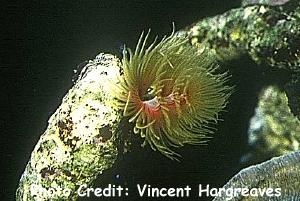
By Bob Goemans

Likely Reef Tank Suitable
Likely Fish-Only Tank Suitable
Range: Indo-West Pacific Ocean
Natural Environment: Inhabits rubble and rock regions in current-swept reef slopes where its calcareous tube is cemented to various types of substrate. The closed tail end of the tube is spiraled, with its opposite end open and usually facing into the current. Its branched tentacle crown has two spirals, usually reddish, reddish orange, which collect its nutritional needs, e.g., suspended particulate organic matter and phytoplankton.
General Husbandry: Occasionally seen in the home aquarium trade.
Specimens are better placed near the bottom of the aquarium in shaded areas where gentle to moderate currents will help bring various foodstuffs. Lower areas in the aquarium are more prone to sand disturbances that often produce current swept detritus, a foodstuff that helps provide some nutrition. Stirring of the sandbed near the location of this tubeworm may also bring about a drifting cloud of foodstuffs.
Frequent feedings, at least every other day, with fresh or preserved phytoplankton additives are a 'must' for long term survival. Keep in mind these additives cannot be dispensed directly onto its gills, as the worm will quickly retreat back into its tube. In fact, it's also highly sensitive to changes in light intensity and will usually quickly retreat when a shadow passes over it. Dispense the additive into the aquarium's current and allow it to bring the foodstuff to the worm.
Taxonomy:
Kingdom: Animalia
Phylum: Annelida
Class: Polychaeta
Order: Sabellida
Family: Serpulidae
Genus: Protula
FYI: Since this species lacks an operculum (trap door) to seal off the top entrance of the tube, do not lift it out of the water upside down, as air will enter the tube that can sometimes negatively affect the animal, to what degree depends upon the exposure time. Also, keep in mind it can be preyed upon by animals with a claw, e.g., shrimp or crabs, and/or fishes such as triggerfishes, angelfishes, pufferfishes, and butterflyfishes. If disturbed too often, it will refrain from opening its crown and perish due to starvation. Unfortunately, due to inadequate nutrition and/or improper tankmates, most die within the first year of captivity.
Much attention should be given to maintaining proper calcium and alkalinity levels as noted below.
Experience Level: Intermediate
Diet: Filter Feeder
Temperament: Peaceful
Aquarium Environment: Reef or fish-only aquarium
Coral Safe: Yes
Fish Safe: Yes
Invertebrate Safe: Yes
Acclimation Time: >15 minutes
Aquarium Hardiness: Moderately hardy
Calcium (Ca): 380 - 430 mg/l
Alkalinity: 2.5 - 3.0 meq/l
Phosphate (PO4): <0.05 mg/l
Magnesium (Mg): approx. 1350 mg/l (relate to specific gravity)
Strontium (Sr) 8 - 10 mg/l
Iodine (I) Trace element additives containing iodine should be used as recommended by their makers.
Temperature Range: 72 - 83°F (22 - 28°C)
Minimum Tank Size: 30 gallons
Lighting: PAR ratings N/A
Water Movement: WM 1 - 2
Specific Gravity: 1.023 - 1.025
pH: 8.0 - 8.4

.jpg)